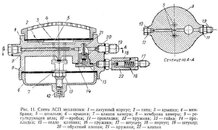I concur. No major difference. A detail difference might be that a better than dumb "auto BCD" (just for life saving or for full Auto? ... let's just shelf that thought for the moment) might want to be programmed such that it learns and updates the system latency and hysteresis each dive so as to respond and time solenoid times correctly for different divers, different suits, no suits, old stiff neoprene, soft squishy, thick, thin, dry w/oinsulation and Michelin Man...I am an engineer. Conceptually there is no difference. You are opening and closing solenoids based on inputs to a control algorithm. The implementation is different but not by much. Sensors provide input to an algorithm that controls valves.
Reaction to a failure of the system also seems similar. Identify an out of control ascent - disconnect the supply and dump the air in the wing. How is this different from an uncontrolled ascent in any diving? How is this different that your reaction to a stuck O2 solenoid?
The major difference is really in the purpose. We are discussing an emergency device not an autopilot BC. If you become unresponsive at depth what are your options? Drowning if no action is taken. A less than perfect device that would get you moving to the surface doesn’t seem like a horrible alternative. Yes it could fail. If you’re conscious you react. If not it’s a matter of whether or not you are better off at depth or on your way to the surface.
I don’t dive an eCCR and I’m not arguing for this device either. But if someone can justify accepting the failure risk of one it is not much of a leap to accepting the other.
I’ll stick to OC diving.
But that is entirely doable by designing the SW right and cognitive of what matters to make the call. A DC with pressure transducer should suffice for input... a very, very, very reliable one and maybe with back up... Power must be infallible too... etc...
It may get trickier in SW and verification of it's robustness with down currents etc. but still should be quite manageable
Wether the thing would be used in some sort of diver enters next target depth mode kind of "let the BCD do it" way plus - or just in some kind of "no diver response in such an amount of time default to safe ascend from dive at this point" mode is almost irrelevant for engineering it. The big problem in making sense of it is to figure out a truly fail safe trigger for this sort of auto unresponsive diver ascend mode. A timer is (diver did not respond in such and such a time) would not work well with distracted divers (photographers, task loaded but OK, seing the sight of a life time...). A great and reliable input of the diver's pertinent biomedical signals might make more sense. That's where it would get tricky...
A simple "oh **** failsafe button to push" (lift cap, push button) is easy and if the ascend profile is safe (very doable) also truly safe, except it requires the diver to be able to do that... and of course a safe ascend, pending on where from in the dive can be quite slow... and may not be the best ascend to try to safe a life, pending on what the situation is (i.e. no gas being drawn in the past minute might indicate that a 6 minute ascend might not help much...) No final conclusion here, except to say that how to trigger and based on what inputs is the tricky part, the "Auto BCD regulating" part itself less so.
Edit: All that said, I am happy fine and content with cruising solo in full manual mode... And I'de be highly unlikly to trust software to not shoot me into an embolism unless... Most SW is written these days in the "write it and fix bugs later" mode and endless bugfixes are the result. The fact that smartly purpose built well pre-planned SW can indeed be bugfree and that the SW architecture can indeed foresee all it needs to foresee (on a limited overseeable scope, which this is) is thought to be an impossibility these days. I would not want to dive such a device if engineered any other way than the "it has to be bugfree and fail safe" way. I realize I am more than a bit odd in seeing that as entirely achievable... and if such a device is engineered by people who do not think that achievable and hence do not even try in earnest ... then it's not for me...
(Bugs must be kept out by design. Finding them in the "end inspection" works as badly for SW as for other industries, but it has become the mode SW seems to be made).
Last edited:




